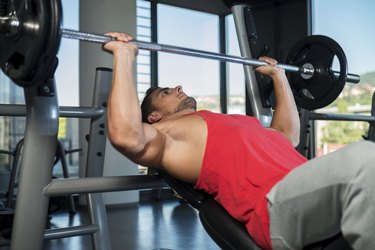
Getting a bigger torso involves a straightforward combination of heavy weight training and eating like it's your job. That's right, in order to see significant gains in your upper body, you need to push really hard in the gym and in the kitchen. Neither of these are easy and both take time -- but in order to create the "V-Shape" in your upper body, they are the only way to go.
Triple Threat Training
Video of the Day
You can train your upper body three times per week. One workout can focus on your chest and back, one can focus on your arms and shoulders and the last can focus on your entire torso. Your chest and back workout should include exercises such as bench presses, bent-over rows, pullups, dumbbell flyes and hyperextensions. Your arm and shoulder workout should include shoulder presses, lateral raises, overhead triceps extensions, biceps curls, triceps pushdowns and dumbbell shrugs. Your whole body workout should be a combination of these exercises. For each workout, perform four sets, with six to ten repetitions of each exercise. Just be sure to take a full day off between each workout in order to give your muscles time to repair and recover.
Video of the Day
Always Be Loading
Progressive overload is the key to growth. Hypertrophy, the process that causes your muscles to get bigger, is triggered by progressive overload. Adding extra weight or aiming to do one or two extra reps per exercise are both classic overload techniques. Both options force your muscles to adapt and grow to meet this new level of challenge. Keep in mind, however, that it's key that your form is correct for every repetition before you add more load. There's no point doing the exercise incorrectly for the sake of overloading -- you simply won't get the benefits of the exercise and run the risk of injury.
Eat Like It's Your Job
To see any significant muscle growth, you have to be providing your body with sufficient calories and macronutrients. Exercise science expert Brad Schoenfeld recommends a caloric intake of 18 to 20 calories per pound of body weight (for example, 3600 to 4000 calories if you weigh 200 pounds). Aim to keep your food intake as nutritious as possible. Focus on lean meats, eggs, nuts, whole grains and starchy vegetables like sweet potato and pumpkin. Avoiding scarfing down processed food in the quest for calories, as you'll put on much more fat than you need and then undo some of your muscular gains when you try to lose it.
Sprints: The Secret To Getting Shredded
Once you get the big torso you want from all this training and eating, it may be time to cut down your body fat a little. Sprinting is an excellent way to help you lose excess body fat without risking your lean muscle mass being catabolized by long-endurance cardio. Sprinting triggers growth hormone, which helps you to maintain muscle mass, while also forcing your body to draw on its fat stores to fuel such high-intensity training. Sprinting is also very effective for defining your abdominal muscles, which are the finishing touch of a big, muscular torso.
- ExRx.Net: 3 Day Split Workout
- American Council on Exercise: Shoulders and Arms Workout
- Bret Contreras: The Ten Rules of Progressive Overload
- T Nation: 4 Reasons You're Not Gaining Muscle
- SimplyShredded.com: Crank It Up: Sprinting Towards Single Digit Body Fat Percentages With High Intensity Training